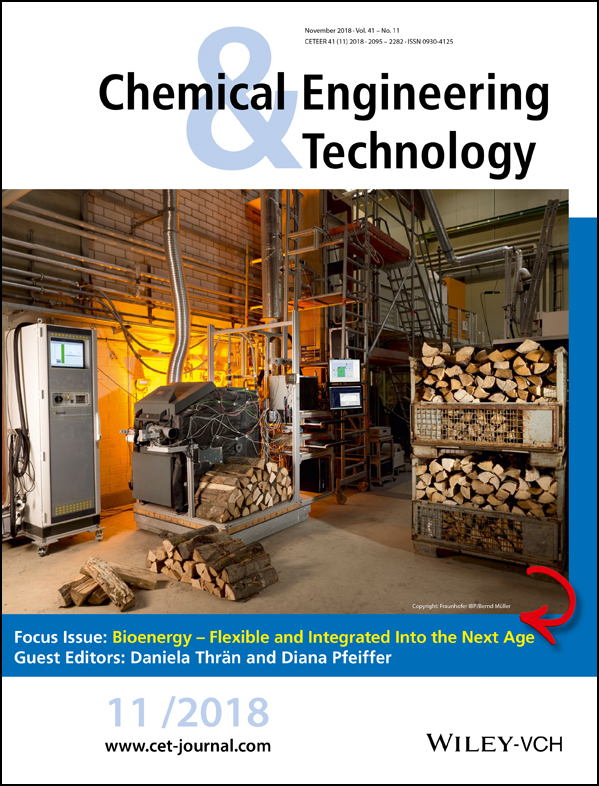Air-Jet Experimental Study and Modeling of Attrition Behavior for Fluid Catalytic Cracking Catalysts
Saba Foroutan Ghazvini
Iran Polymer and Petrochemical Institute, Faculty of Petrochemicals, P.O. Box 14965/115, 14977-13115 Tehran, Iran
Search for more papers by this authorCorresponding Author
Ali Afshar Ebrahimi
Iran Polymer and Petrochemical Institute, Faculty of Petrochemicals, P.O. Box 14965/115, 14977-13115 Tehran, Iran
Correspondence: Ali Afshar Ebrahimi ([email protected]), Iran Polymer and Petrochemical Institute, Faculty of Petrochemicals, P.O. Box 14965/115, Tehran 14977-13115, Iran.Search for more papers by this authorSaba Foroutan Ghazvini
Iran Polymer and Petrochemical Institute, Faculty of Petrochemicals, P.O. Box 14965/115, 14977-13115 Tehran, Iran
Search for more papers by this authorCorresponding Author
Ali Afshar Ebrahimi
Iran Polymer and Petrochemical Institute, Faculty of Petrochemicals, P.O. Box 14965/115, 14977-13115 Tehran, Iran
Correspondence: Ali Afshar Ebrahimi ([email protected]), Iran Polymer and Petrochemical Institute, Faculty of Petrochemicals, P.O. Box 14965/115, Tehran 14977-13115, Iran.Search for more papers by this authorAbstract
Fluid catalytic cracking (FCC) processes employ microspheroidal catalyst particles, which play a significant role in the most important part of a refinery. These catalysts are subject to attrition because of the nature of FCC process circulation in the reactor regenerator. Attrition tests according to the American Society for Testing and Materials (ASTM) standards were carried out for two FCC catalysts in both fresh and spent forms. Attrition characteristics and catalyst resistance were investigated by particle size distribution and scanning electron microscopy. Response surface methodology using a central composite design was applied to simulate the mass distribution of samples in the downstream. This method was used to investigate the effect of time on attrition behavior of fresh and spent forms of the catalysts.
References
- 1 R. Boerefijin, N. J. Gudde, M. Ghadiri, Adv. Powder Technol. 2000, 11 (2), 145–174. DOI: https://doi.org/10.1163/156855200750172286
- 2 S. Kukade, P. Kumar, P. V. C. Rao, N. V. Choudary, Powder Technol. 2016, 301, 472–477. DOI: https://doi.org/10.1016/j.powtec.2016.06.040
- 3 J. Werther, J. Reppenhagen, in Handbook of Fluidization and Fluid-Particle Systems (Ed: W. C. Yang), Marcel Dekker, New York 2003.
- 4 B. Ambelard, S. Bertholin, C. Bobin, T. Gauthier, Powder Technol. 2015, 274, 455–465. DOI: https://doi.org/10.1016/j.powtec.2015.01.001
- 5 C. R. Bemrose, J. Bridgewater, Powder Technol. 1987, 49 (2), 97–126. DOI: https://doi.org/10.1016/0032-5910(87)80054-2
- 6 J. Wei, W. Lee, F. J. Krambeck, Chem. Eng. Sci. 1977, 32 (10), 1211–1218. DOI: https://doi.org/10.1016/0009-2509(77)80054-7
- 7 J. Werther, J. Reppenhagen, AIChE J. 1999, 45 (9), 2001–2010. DOI: https://doi.org/10.1002/aic.690450916
- 8 P. R. Tardin, L. Goldstein, G. Lombardi, J. D. Paglioso, Ind. Eng. Chem. Res. 2001, 40 (19), 4141–4150. DOI: https://doi.org/10.1021/ie990816c
- 9 Z. X. Chen, J. R. Grace, C. J. Lim, Powder Technol. 2011, 207 (1–3), 55–64. DOI: https://doi.org/10.1016/j.powtec.2010.10.010
- 10 L. H. Teng, J. Zhejiang Univ., Sci., A 2008, 9 (9), 1288–1295. DOI: https://doi.org/10.1631/jzus.A0820155
- 11 J. McMillan, C. Briens, F. Berruti, E. Chan, Powder Technol. 2007, 175 (3), 133–141. DOI: https://doi.org/10.1016/j.powtec.2007.02.004
- 12 F. Li, C. Briens, F. Berruti, J. McMillan, Powder Technol. 2012, 228, 385–394. DOI: https://doi.org/10.1016/j.powtec.2012.05.057
- 13 J. H. Choi, Y. S. Moon, C. K. Yi, J. Taiwan Inst. Chem. Eng. 2010, 41 (6), 656–660. DOI: https://doi.org/10.1016/j.jtice.2010.01.011
- 14 Y. C. Ray, T. S. Jiang, C. Y. Wen, Powder Technol. 1987, 49 (3), 193–206. DOI: https://doi.org/10.1016/0032-5910(87)80128-6
- 15 J. A. Hao, Y. F. Zhao, M. Ye, Z. M. Liu, Adv. Powder Technol. 2015, 26 (3), 734–741. DOI: https://doi.org/10.1016/j.apt.2015.03.010
- 16 T. Chiranjeevi, N. Ravichander, D. T. Gokak, V. Ravikumar, N. V. Choudary, Pet. Sci. Technol. 2014, 32 (4), 470–478. DOI: https://doi.org/10.1080/10916466.2011.592894
- 17 F. Wu, D. Wu, Powder Technol. 2017, 305, 289–296. DOI: https://doi.org/10.1016/j.powtec.2016.09.077
- 18 W. L. Forsythe, W. R. Hertwig, J. Ind. Eng. Chem. 1949, 41 (6), 1200–1206. DOI: https://doi.org/10.1021/ie50474a015
- 19 J. E. Gwyn, AIChE J. 1969, 15 (1), 35–39. DOI: https://doi.org/10.1002/aic.690150112
- 20ASTM-D-5757-00, Standard Test Method for Determination of Attrition and Abrasion of Powdered Catalysts by Air Jet, ASTM, West Conshohocken, PA 2006.
- 21 R. M. Contractor, H. E. Bergna, U. Chouwdhury, A. W. Sleight, in Fluidization VI (Eds: J. R. Grace, L. W. Schemilt, M. A. Bergougnou), Engineering Foundation, New York 1989.
- 22 L. Cairati, D. Fiore, P. Forzatti, I. Posquon, F. Trifiro, Ind. Eng. Chem. Process Des. Dev. 1980, 19 (4), 561–565. DOI: https://doi.org/10.1021/i260076a010
- 23 J. Werther, W. Xi, Powder Technol. 1993, 76 (1), 39–46. DOI: https://doi.org/10.1016/0032-5910(93)80039-D
- 24 G. Donshi, L. Massimilla, L. Colantuoni, in Fluidization (Eds: J. R. Grace, J. M. Matsen), Plenum, New York 1980.
- 25 M. Ghadiri, J. A. S. Cleaver, V. G. Tuponogov, J. Werther, Powder Technol. 1994, 80 (2), 175–178. DOI: https://doi.org/10.1016/0032-5910(94)80014-6
- 26 T. Taylor, in World Congr. on Particle Technology 3, Institution of Chemical Engineers, Rugby, 1998, paper 160.
- 27 S. A. Weeks, P. Dumbill, Oil Gas J. 1990, 88, 38–40.
- 28
T. Allen, in Particle Size Measurement, Chapman & Hall, London
1990.
10.1007/978-94-009-0417-0 Google Scholar
- 29 J. L. Bass, R. E. Ritter, J. Mater. Sci. 1977, 12 (3), 583–594.
- 30 R. Zhao, J. G. Goodwin, K. Jothimurugesan, J. J. Spivey, S. K. Gangwall, Ind. Eng. Chem. Res. 2000, 39 (5), 1155–1158. DOI: https://doi.org/10.1021/ie990730j
- 31 G. E. P. Box, K. B. Wilson, in Breakthroughs in Statistics Volume II: Methodology and Distribution (Eds: S. Kotz, N. L. Johnson), Springer Series in Statistics, Springer, New York 1992.
- 32 M. Ghadiri, Z. Ning, S. J. Kenter, E. Puik, Chem. Eng. Sci. 2000, 55 (22), 5445–5456. DOI: https://doi.org/10.1016/S0009-2509(00)00168-8
- 33 R. Zhao, J. James, J. Goodwin, R. Oukaci, Appl. Catal., A 1999, 189 (1), 99–116. DOI: https://doi.org/10.1016/S0926-860X(99)00261-6




